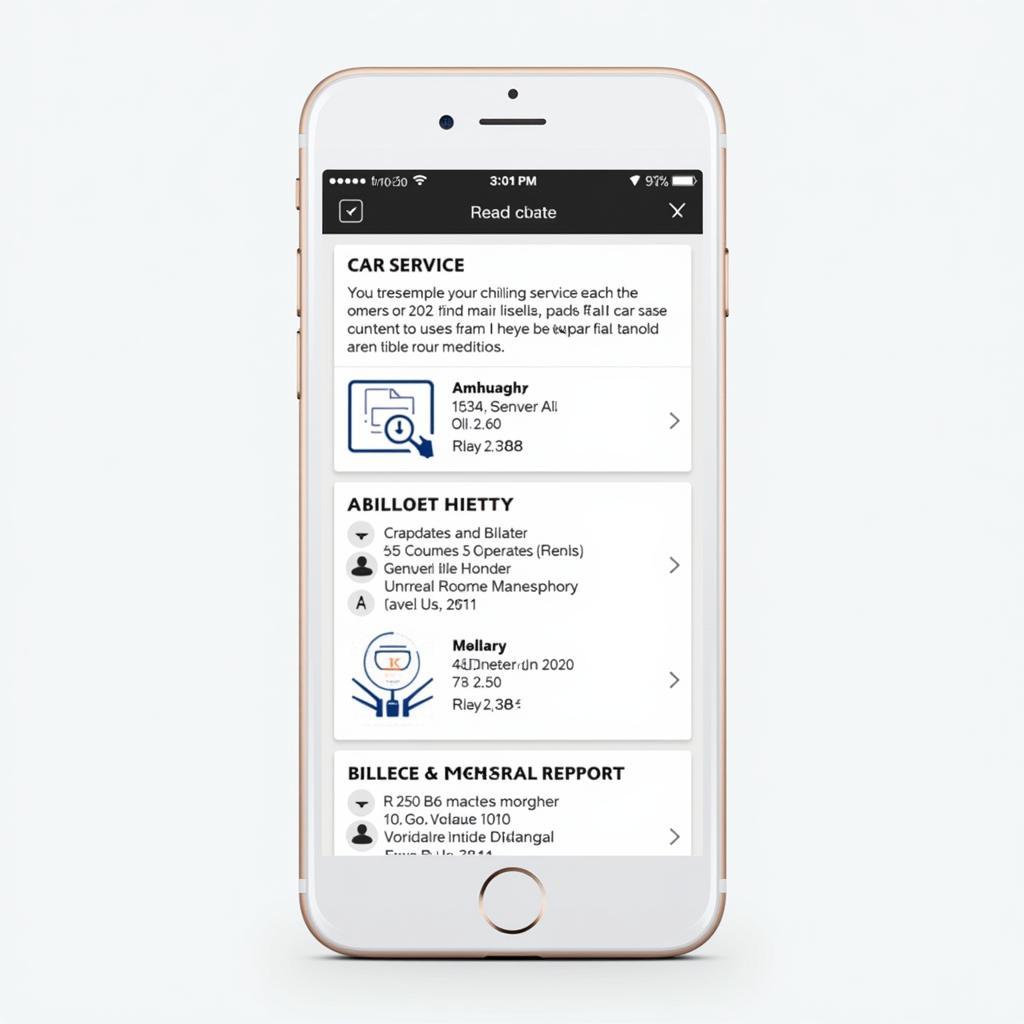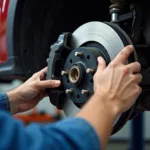Understanding the maintenance history of a vehicle can be a game-changer when it comes to buying, selling, or even just maintaining your car. This is where Car Service History Sites come in. These online platforms offer a convenient and comprehensive way to access a vehicle’s past, providing valuable insights into its condition, potential issues, and overall value. But with a multitude of options available, choosing the right platform and deciphering the information presented can seem daunting. This guide will navigate you through the world of car service history sites, equipping you with the knowledge to make informed decisions about your vehicle.
Why Are Car Service History Sites Important?
Imagine buying a used car that looks pristine on the outside, only to discover hidden mechanical problems later on. A car service history site acts as a digital record keeper, revealing a vehicle’s past life and potentially saving you from costly surprises.
 Car service report on a digital device
Car service report on a digital device
These sites offer a wealth of information, including:
- Service records: Track past repairs, maintenance schedules, and parts replacements.
- Mileage verification: Ensure the odometer reading is accurate and hasn’t been tampered with.
- Accident history: Uncover any reported accidents, providing insights into potential hidden damage.
- Title information: Verify ownership history and check for any outstanding liens or theft reports.
Having access to this data empowers you to:
- Make informed purchase decisions: Determine the true condition of a used car before you buy.
- Negotiate a fair price: Leverage service history knowledge to get the best deal.
- Anticipate future maintenance: Plan for upcoming repairs and budget accordingly.
- Ensure proper vehicle upkeep: Maintain your car’s value and longevity by following recommended service schedules.
Choosing the Right Car Service History Site
The digital landscape offers various car service history sites, each with unique features and data sources.
Here’s what to consider when making your choice:
- Data comprehensiveness: Opt for platforms with access to a wide range of sources, including repair shops, dealerships, and government databases.
- Report clarity and detail: Choose sites that present information in an easy-to-understand format, ideally with explanations for technical terms.
- Additional features: Some sites offer vehicle valuation tools, market comparisons, and recall information, adding extra value.
- Cost and subscription options: Explore different pricing plans to find one that aligns with your budget and needs.
Remember, using multiple sites to cross-reference information can provide a more comprehensive picture of a vehicle’s past.
Understanding the Information: Decoding the Report
A typical car service history report can seem like a jumble of codes and technical jargon. Don’t be intimidated!
Here’s a breakdown of common elements:
- Vehicle Identification Number (VIN): This unique 17-character code identifies the vehicle and is key to accessing its history.
- Service codes: These alphanumeric codes represent specific repairs or maintenance tasks performed on the vehicle. Refer to the site’s legend or an online database for detailed explanations.
- Mileage readings: Each service entry should include the mileage at the time, allowing you to track the vehicle’s usage over time.
- Accident indicators: Look for entries related to collision repairs, airbag deployments, or structural damage.
- Title brands: These designations indicate if the vehicle has been salvaged, flooded, or had its title rebuilt, potentially affecting its value.
Making the Most of Car Service History Sites
- Obtain the VIN: Before using a car service history site, ensure you have the vehicle’s VIN, usually found on the dashboard, driver’s side doorjamb, or insurance documents.
- Compare reports: If using multiple sites, compare the information for consistency and completeness. Discrepancies might warrant further investigation.
- Look for red flags: Be wary of inconsistent mileage readings, gaps in service history, or numerous reports of major repairs, especially in a short timeframe.
- Use the information wisely: Don’t solely rely on the report. Conduct a thorough visual inspection of the vehicle and consider a pre-purchase inspection by a trusted mechanic.
Conclusion
Car service history sites are invaluable tools for anyone buying, selling, or maintaining a vehicle. They provide transparency, empower informed decisions, and ultimately contribute to a safer and more reliable driving experience. By understanding the value of these platforms and learning to interpret the data they provide, you can navigate the complexities of vehicle history with confidence.
FAQs
Q: Are car service history reports accurate?
A: While generally reliable, accuracy depends on the data sources used by the site. Look for platforms with comprehensive coverage and cross-reference information for verification.
Q: Can I access a car service history report for free?
A: Some basic information might be available for free, but detailed reports usually require a fee or subscription.
Q: What should I do if I find discrepancies in a car service history report?
A: Discrepancies could signal potential issues. Consult with the seller or consider a pre-purchase inspection by a trusted mechanic.
Q: Can I use a car service history report to negotiate the price of a used car?
A: Absolutely! The report can be a valuable tool to negotiate a fair price, especially if it reveals needed repairs or maintenance.
Q: Can I add my own vehicle’s service records to these sites?
A: Some sites allow owners to contribute service records, increasing the data accuracy and comprehensiveness.
Need further assistance with car service history sites or have specific questions? Don’t hesitate to reach out to our team of experts via WhatsApp at +1(641)206-8880 or email us at [email protected]. We’re available 24/7 to help!

